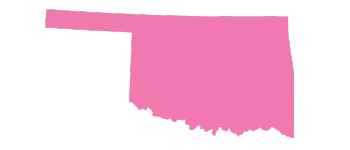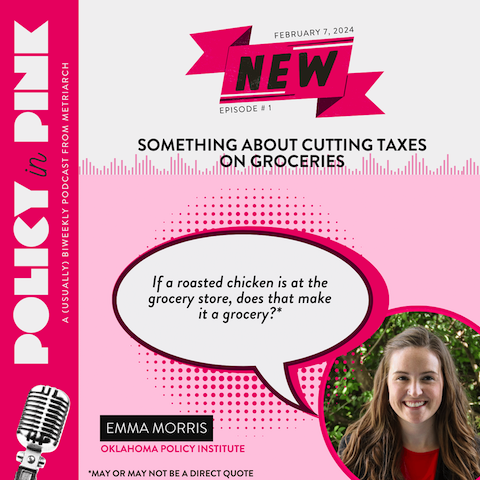Data highlight
New Mexico has the highest percentage of women who are insured by Medicaid at 32%. There’s a three-way tie for lowest; 9% of women in Wyoming, Utah, and South Dakota are insured by Medicaid. 18% of women in Oklahoma are enrolled in SoonerCare, putting us near the middle.1Kaiser Family Foundation, “Women’s Health Insurance Coverage.” December 13, 2023.
HOW WE STACK UP
Percent of women ages 19-64 enrolled in Medicaid


Source: Kaiser Family Foundation
YOU MIGHT ALSO LIKE
Definition
Medicaid is a government program that provides health coverage to low-income individuals and families. The federal government sets overall guidelines, while individual states manage and implement the program, tailoring it to their specific needs within federal parameters. The program is funded jointly by federal and state governments.
SoonerCare is the name for Oklahoma’s Medicaid program. It is administered by the Oklahoma Health Care Authority (OHCA) and helps cover medical expenses such as doctor visits, hospital stays, and prescription medications for those who are eligible.
Why we care
For low-income Oklahomans, Medicaid (SoonerCare) provides vital coverage for health-related expenses. It ensures access to necessary medical services and treatments for chronic conditions for individuals who would likely have been unable to afford them. It facilitates access to primary care doctors, dentists, and necessary prescription drugs.
This is especially important for women in their reproductive years, whose healthcare needs often include family planning and pregnancy-related care.
Pregnancy and childbirth in particular can be a major financial burden. Nationally, pregnancy-associated costs averaged a total of $18,865 in 2020.2Matthew Rae, Cynthia Cox, and Hanna Dingel. “Health costs associated with pregnancy, childbirth, and postpartum care.” Peterson-KFF Health System Tracker. July 13, 2022. That’s over $3,000 more than someone working a full-time, minimum wage job in Oklahoma can hope to bring home in a year.
More women than men are on Medicaid nationally, a trend that holds true in Oklahoma.3“Women’s Health Insurance Coverage.” Kaiser Family Foundation, kff.org. December 13, 2023. This is mostly because women make less money (see Gender Pay Gap) and are more likely to live at or below the poverty line (see Women Experiencing Poverty).
State Medicaid programs are required to cover some preventive services that are critical for women’s health. Breast and cervical cancer screenings are especially important, and data shows that women on Medicaid get pap smears and mammograms nearly as often as those with private insurance.4Ivette Gomez, Usha Ranji, Alina Salganicoff, and Brittni Frederiksen. “Medicaid Coverage for Women.” Kaiser Family Foundation, kff.org. February 17, 2022. Earlier, more consistent screening makes for lower mortality rates.
More expansive Medicaid programs with higher enrollment aren’t just good for women’s health. They save taxpayer dollars. Preventive care for more people offsets state spending on clinics, mental health facilities, and hospital emergency rooms. And more federal dollars in the local healthcare economy means more state tax revenue and a stronger economy for everyone.5David Slusky, “Impact of Medicaid Expansion on State Budgets and Mortality.” Econofact, econofact.org. July 21, 2021.
Considerations
The Sooner State has seen major changes to our Medicaid program in the last five years, many directly benefiting women. The impact of these improvements is still being analyzed.
The most notable reform was State Question (SQ) 802, a successful ballot initiative that expanded Medicaid in Oklahoma, which is an option under the Affordable Care Act.6“Medicaid Expansion.” Oklahoma Health Care Authority, oklahoma.gov/ohca. May 30, 2023. When SQ 802 was implemented in 2021, Oklahomans with incomes below 138% of the federal poverty level (FPL) – about $30,000 for a family of four – became became eligible for health benefits through SoonerCare.
On January 1, 2023, following recommendations from Governor Kevin Stitt’s Helping Every Life and Parent (H.E.L.P.) Task Force, OHCA further further expanded coverage for pregnant and postpartum individuals.7Office of Governor J. Kevin Stitt, “Governor Stitt Praises Expanded Coverage for New Mothers.” News release. March 27, 2023. SoonerCare’s income threshold for full-scope pregnancy-related benefits increased from 138% to 205% of the FPL, and members are now guaranteed twelve months of continuous coverage after their pregnancy ends.
On July 1, 2023, Oklahoma became the 11th state to cover doula services under our Medicaid program.8“Oklahoma adds doula services to SoonerCare benefits.” Oklahoma Health Care Authority, oklahoma.gov/ohca. News release, July 10, 2023. SoonerCare members who are pregnant or within the one-year postpartum period are now eligible for up to eight doula visits per pregnancy.
A change to the way Medicaid programs were administered during the COVID-19 pandemic had an additional effect on enrollment data from early 2020 through December 2023. The federal government prohibited states from disenrolling people from Medicaid during the pandemic, resulting in significant increases in enrollment. Uninsured rates reached record lows while Medicaid enrollment swelled to record highs.
When the Public Health Emergency ended in April of 2023, states were required to reassess members’ eligibility and disenroll those who were no longer eligible or unable to complete the renewal process. OHCA completed the process in December of 2023, having unenrolled over 300,000 Oklahomans.9Matthew Rae, Cynthia Cox, and Hanna Dingel. “Health costs associated with pregnancy, childbirth, and postpartum care.” Peterson-KFF Health System Tracker. July 13, 2022.
What we can do:
- Increase awareness of recent SoonerCare expansions and extensions, which ensures more eligible mothers have coverage for at least a year after birth and access to doula services.
- Partner with clinics and providers in underserved areas to aid patients through the SoonerCare and Soon-to-be Sooner application process.
- Use Section 1115 waivers to better leverage Medicaid to expand eligibility and benefits, reduce health disparities, and address social determinants of health.
- Leverage increased flexibility of Medicaid managed care organizations (MCOs) to provide “value-added” and “in-lieu-of-services” – non-medical services that address social determinants of health, such as in-home prenatal visits for high-risk beneficiaries or safe sleeping spaces for infants.
- Enhance real-time and cross-program eligibility processes.
This issue brief was written by Metriarch staff as part of our Data Lookbook. Contributions and peer review were provided by Emma Morris with Oklahoma Policy Institute.
Suggested citation
Metriarch. “Access to Quality Care,” Data Lookbook (2024). URL: metriarchok.org/women-enrolled-in-soonercare/.
- Last updated December 16, 2024
Share this page:





